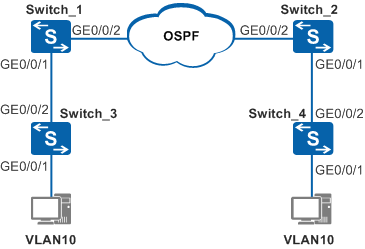Example for Configuring VLANIF Interfaces to Implement Intra-VLAN Communication
Networking Requirements
In Figure 1, Switch_1 and Switch_2 are connected to Layer 2 networks that VLAN 10 belongs to. Switch_1 communicates with Switch_2 through a Layer 3 network with OSPF enabled.
PCs of the two Layer 2 networks need to be isolated at Layer 2 and interwork at Layer 3.
Configuration Roadmap
Add interfaces to VLANs and configure the interfaces to allow the VLANs.
Configure IP addresses for VLANIF interfaces to implement Layer 3 connectivity.
Configure basic OSPF functions to implement Layer 3 interworking.
Procedure
- Configure Switch_1.
# Create VLAN 10 and VLAN 30.
<HUAWEI> system-view [HUAWEI] sysname Switch_1 [Switch_1] vlan batch 10 30
# Add GE0/0/1 to VLAN 10 and GE0/0/2 to VLAN 30.
[Switch_1] interface gigabitethernet 0/0/1 [Switch_1-GigabitEthernet0/0/1] port link-type trunk [Switch_1-GigabitEthernet0/0/1] port trunk allow-pass vlan 10 [Switch_1-GigabitEthernet0/0/1] quit [Switch_1] interface gigabitethernet 0/0/2 [Switch_1-GigabitEthernet0/0/2] port link-type trunk [Switch_1-GigabitEthernet0/0/2] port trunk allow-pass vlan 30 [Switch_1-GigabitEthernet0/0/2] quit
# Configure IP addresses of 10.10.10.1/24 for VLANIF 10 and 10.10.30.1/24 for VLANIF 30.
[Switch_1] interface vlanif 10 [Switch_1-Vlanif10] ip address 10.10.10.1 24 [Switch_1-Vlanif10] quit [Switch_1] interface vlanif 30 [Switch_1-Vlanif30] ip address 10.10.30.1 24 [Switch_1-Vlanif30] quit
# Configure basic OSPF functions.
[Switch_1] router id 1.1.1.1 [Switch_1] ospf [Switch_1-ospf-1] area 0 [Switch_1-ospf-1-area-0.0.0.0] network 10.10.10.0 0.0.0.255 [Switch_1-ospf-1-area-0.0.0.0] network 10.10.30.0 0.0.0.255 [Switch_1-ospf-1-area-0.0.0.0] quit
- Configure Switch_2.
# Create VLAN 10 and VLAN 30.
<HUAWEI> system-view [HUAWEI] sysname Switch_2 [Switch_2] vlan batch 10 30
# Add GE0/0/1 to VLAN 10 and GE0/0/2 to VLAN 30.
[Switch_2] interface gigabitethernet 0/0/1 [Switch_2-GigabitEthernet0/0/1] port link-type trunk [Switch_2-GigabitEthernet0/0/1] port trunk allow-pass vlan 10 [Switch_2-GigabitEthernet0/0/1] quit [Switch_2] interface gigabitethernet 0/0/2 [Switch_2-GigabitEthernet0/0/2] port link-type trunk [Switch_2-GigabitEthernet0/0/2] port trunk allow-pass vlan 30 [Switch_2-GigabitEthernet0/0/2] quit
# Configure VLANIF 10 and VLANIF 30 with IP addresses 10.10.20.1/24 and 10.10.30.2/24 respectively.
[Switch_2] interface vlanif 10 [Switch_2-Vlanif10] ip address 10.10.20.1 24 [Switch_2-Vlanif10] quit [Switch_2] interface vlanif 30 [Switch_2-Vlanif30] ip address 10.10.30.2 24 [Switch_2-Vlanif30] quit
# Configure basic OSPF functions.
[Switch_2] router id 2.2.2.2 [Switch_2] ospf [Switch_2-ospf-1] area 0 [Switch_2-ospf-1-area-0.0.0.0] network 10.10.20.0 0.0.0.255 [Switch_2-ospf-1-area-0.0.0.0] network 10.10.30.0 0.0.0.255 [Switch_2-ospf-1-area-0.0.0.0] quit
- Configure Switch_3.
# Create VLAN 10, add GE0/0/1 to VLAN 10 in untagged mode and GE0/0/2 to VLAN 10 in tagged mode. The configuration of Switch_4 is the same as that of Switch_3.
<HUAWEI> system-view [HUAWEI] sysname Switch_3 [Switch_3] vlan batch 10 [Switch_3] interface gigabitethernet 0/0/1 [Switch_3-GigabitEthernet0/0/1] port link-type access [Switch_3-GigabitEthernet0/0/1] port default vlan 10 [Switch_3-GigabitEthernet0/0/1] quit [Switch_3] interface gigabitethernet 0/0/2 [Switch_3-GigabitEthernet0/0/2] port link-type trunk [Switch_3-GigabitEthernet0/0/2] port trunk allow-pass vlan 10 [Switch_3-GigabitEthernet0/0/2] quit
- Verify the configuration.
On the PC of the Layer 2 network connected to Switch_1, set the default gateway address to 10.10.10.1/24 (the IP address of VLANIF10).
On the PC of the Layer 2 network connected to Switch_2, set the default gateway address to 10.10.20.1/24 (the IP address of VLANIF10).
After the configuration is complete, PCs on the two Layer 2 networks are isolated at Layer 2 and interwork at Layer 3.
Configuration Files
Switch_1 configuration file
# sysname Switch_1 # router id 1.1.1.1 # vlan batch 10 30 # interface Vlanif10 ip address 10.10.10.1 255.255.255.0 # interface Vlanif30 ip address 10.10.30.1 255.255.255.0 # interface GigabitEthernet0/0/1 port link-type trunk port trunk allow-pass vlan 10 # interface GigabitEthernet0/0/2 port link-type trunk port trunk allow-pass vlan 30 # ospf 1 area 0.0.0.0 network 10.10.10.0 0.0.0.255 network 10.10.30.0 0.0.0.255 # return
Switch_2 configuration file
# sysname Switch_2 # router id 2.2.2.2 # vlan batch 10 30 # interface Vlanif10 ip address 10.10.20.1 255.255.255.0 # interface Vlanif30 ip address 10.10.30.2 255.255.255.0 # interface GigabitEthernet0/0/1 port link-type trunk port trunk allow-pass vlan 10 # interface GigabitEthernet0/0/2 port link-type trunk port trunk allow-pass vlan 30 # ospf 1 area 0.0.0.0 network 10.10.20.0 0.0.0.255 network 10.10.30.0 0.0.0.255 # return
Switch_3 configuration file
# sysname Switch_3 # vlan batch 10 # interface GigabitEthernet0/0/1 port link-type access port default vlan 10 # interface GigabitEthernet0/0/2 port link-type trunk port trunk allow-pass vlan 10 # return
Switch_4 configuration file
# sysname Switch_4 # vlan batch 10 # interface GigabitEthernet0/0/1 port link-type access port default vlan 10 # interface GigabitEthernet0/0/2 port link-type trunk port trunk allow-pass vlan 10 # return
